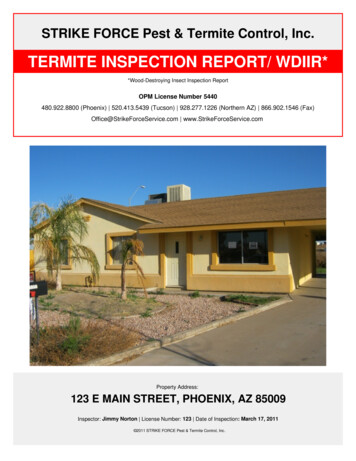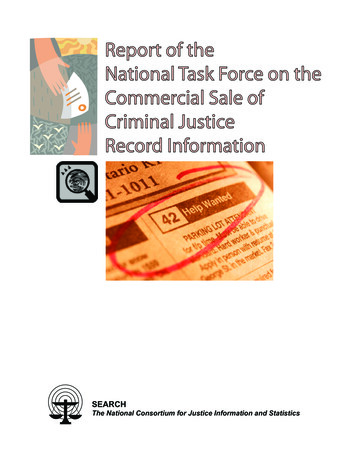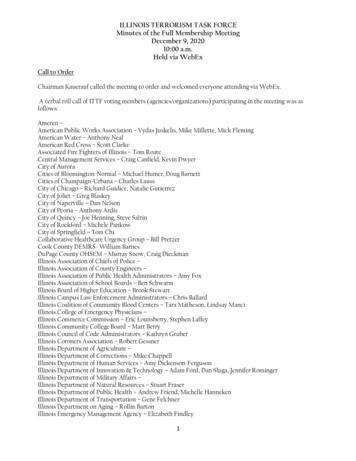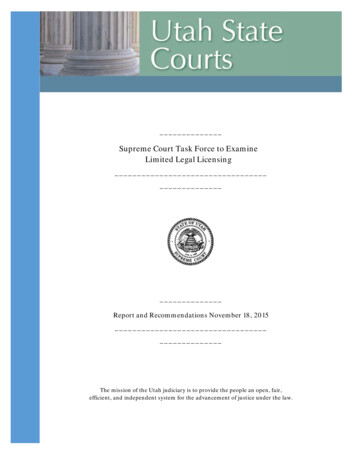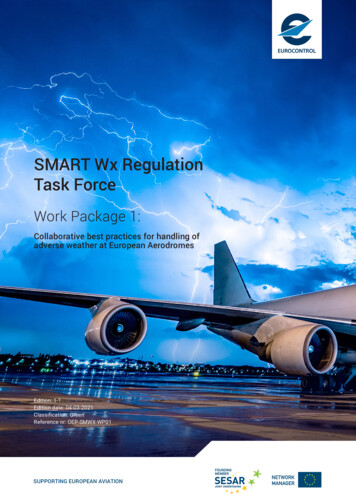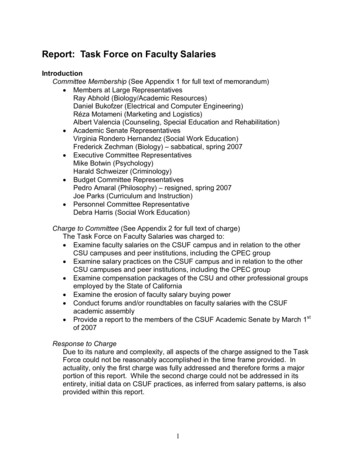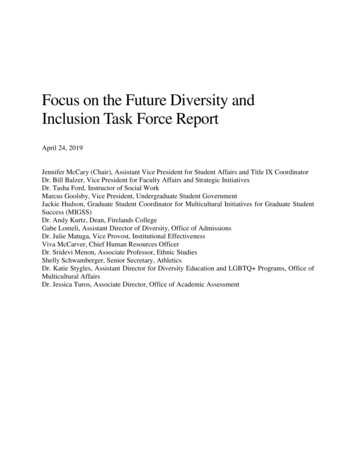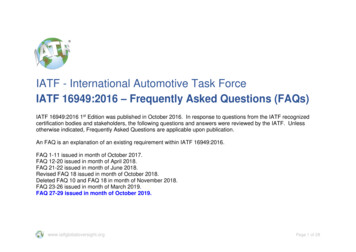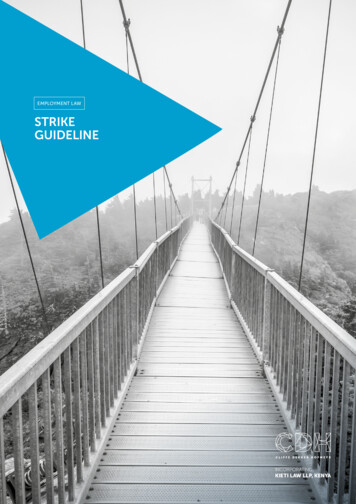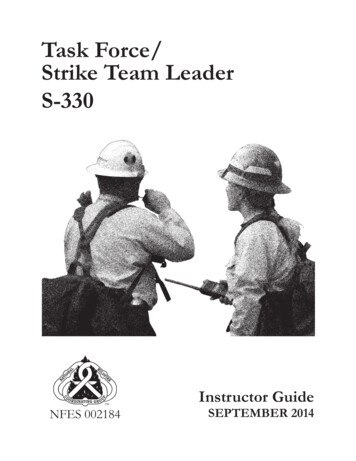
Transcription
Task Force/Strike Team LeaderS-330TMNFES 002184Instructor GuideSEPTEMBER 2014
TMS-330TASK FORCE/STRIKE TEAM LEADERArt for spine.Adjust width as necessaryfor thickness of book.
NWCG OPERATIONS AND WORKFORCE DEVELOPMENT COMMITTEEPOSITION ON COURSE PRESENTATION AND MATERIALSThe recommended hours listed in the FMCG are developed by Subject Matter Experts based on theirestimation of the time required to present all material needed to adequately teach the unit and courseobjectives. The hours listed may vary slightly due to factors such as number of students, types andcomplexity of course activities, and the addition of local materials.NWCG does not approve of course delivery varying greatly from the recommended course hours.Instructors and students are cautioned that in order to be recognized as an NWCG-certified course, certainguidelines must be followed: Lead instructors are encouraged to enhance course materials to reflect the conditions, resources, andpolicies of the local unit and area as long as the objectives of the course and each unit are notcompromised. Exercises can be modified to reflect local fuel types, resources, and conditions at the location wherethe student will likely fill incident assignments. The objectives and intent of the exercises mustremain intact. Test questions may be added that reflect any local information that may have been added to thecourse. However, to ensure the accurate testing of course and unit objectives, test questions in thecertified course materials should not be deleted. Test grades, used to determine successful completion of the course, shall be based only on thequestions presented in the certified course materials.If lead instructors feel that any course materials are inaccurate, information should be submitted either byaccessing the online feedback form at http://training.nwcg.gov/ (select the “NWCG EVAL” button in theupper right corner) or by sending an email to the NWCG Training Branch atBLM FA NWCG training@blm.gov. Materials submitted will be evaluated and, where and whenappropriate, incorporated into the appropriate courses.COURSE LENGTH FOR NWCG COURSESRecommended course hours and the “NWCG Position on Course Presentation and Materials” above willbe adhered to by the course instructors (see below for exception for criteria-based courses). Recommended unit times represent the allotted time to teach the unit and complete the exercises,simulations, and tests. Recommended course hours are provided to help the students and the course coordinator plan fortravel, room reservations, and facilities usage. The recommended course hours represent the timeestimated to present the NWCG-provided materials including time for breaks, lunch periods, to set upfor field exercises or simulations, etc. Actual times for both the unit(s) and the course may vary based on number of students, types andcomplexity of course activities, and the addition of local instructional materials.If the course is criteria based, e.g., L-380, and has been developed using NWCG course criteria, minimumcourse hour requirements have been established and must be adhered to by the course developer andcourse instructors.Course hours for all NWCG courses can be found in the Field Manager’s Course Guide atwww.nwcg.gov/pms/training/training.htm. If the hours are a minimum versus recommended, they will bestated as such.
Task Force/StrikeTeam LeaderS-330Instructor GuideSeptember 2014NFES 002184Sponsored for National Wildfire Coordinating Group (NWCG) publication by the NWCGTraining Committee. Comments regarding the content of this publication should be directed tothe NWCG Training Branch at BLM FA NWCG Training@blm.gov.For additional copies of this publication, go to Publications at http://www.nwcg.gov.Previous editions: this product replaces NFES 2782, Task Force/Strike Team Leader, October2005.The NWCG has approved the contents of this product for the guidance of its member agencies andis not responsible for the interpretation or use of this information by anyone else.NWCG’s intent is to specifically identify all copyrighted content used in NWCG products. All otherNWCG information is in the public domain. Use of public domain information, including copying,is permitted. Use of NWCG information within another document is permitted, if NWCGinformation is accurately credited to the NWCG. The NWCG logo may not be used except onNWCG-authorized information. “National Wildfire Coordinating Group,” “NWCG,” and theNWCG logo are trademarks of the National Wildfire Coordinating Group.The use of trade, firm, or corporation names or trademarks in this product is for the information andconvenience of the reader and does not constitute an endorsement by the National WildfireCoordinating Group or its member agencies of any product or service to the exclusion of others thatmay be suitable.
PREFACETask Force/Strike Team Leader, S-330 is a required training course in the NationalIncident Management System: Wildland Fire Qualification System Guide(PMS 310-1).This course was developed by an interagency group of subject matter experts withdirection and guidance from the National Wildfire Coordinating Group (NWCG)Training Branch.The NWCG appreciates the efforts of these personnel and all those who havecontributed to the development of this training product.i
ii
CONTENTSPREFACE .iCOURSE INSTRUCTIONSIntroduction .1Course Objectives .2Minimum Instructor Qualifications. 2Instructor Preparation and Course Coordination . 2Course Materials .4Student Target Group .6Course Prerequisites .7Pre-Selection Assessment and Pre-Course Work . 7Course Nomination and Selection Letters . 8Cadre Meetings .8Recommended Class Size .9Space and Classroom Requirements . 9Student Assessment and Certification.10Sample Nomination Letter .11Sample Course Selection Letter .13Sample Agenda .15INSTRUCTIONAL UNITSUnit 0 – Introduction .0.1Unit 1 – Pre-Incident and Mobilization Responsibilities .1.1Unit 2 – Pre-Engagement .2.1Unit 3 – Tactical Engagement .3.1Unit 4 – Post Engagement .4.1Unit 5 – Responsibilities and Assessing Risk .5.1Unit 6 – Demobilization .6.1Unit 7 – Military Assignments .7.1Unit 8 – All-Hazards .8.1iii
The following appendixes are located on the Course Materials CD:Appendix A – Course Ordering and Support InformationAppendix B – PowerPoint PresentationsAppendix C – Pre-course WorkAppendix D – Student AssessmentAppendix E – Course Evaluation FormsAppendix F – Marre IAP Exercise Mapiv
COURSE INSTRUCTIONSThis section contains instructions and information essential to the coursecoordinator and instructors in making an effective presentation. Cadremembers must read this section and be thoroughly familiar with courseprocedures and material before presentation.I.INTRODUCTIONThe S-330, Task Force/Strike Team Leader, course requires 19-20½ hoursfor presentation. This course is designed to meet the training needs of a TaskForce Leader (TFLD) and Strike Team Leader (STL) on an incident asoutlined in the National Incident Management System: Wildland FireQualification System Guide (PMS 310-1) and the position task bookdeveloped for the position.The Wildland Fire Qualification System Guide, developed under thesponsorship of the National Wildfire Coordinating Group (NWCG), isdesigned to establish minimum requirements for training, experience,physical fitness level, and currency standards for wildland fire positions,which all participating agencies have agreed to meet for nationalmobilization.To ensure that the most up-to-date material is being presented, instructorsare encouraged to refer to the NWCG Training and Qualifications website.This website contains current updates for all NWCG courses (go tohttp://training.nwcg.gov/).1
II.COURSE OBJECTIVESCourse objectives are stated in broad terms that define what students will beable to accomplish after completing the course.At the successful completion of this course, students will be able to:III. Demonstrate the ability to apply the Risk Management Process foundin the Incident Response Pocket Guide (IRPG) to various incidents. Identify and describe the responsibilities of a Task Force/ Strike TeamLeader (TFLD/STL). Demonstrate the ability to apply appropriate tactics with assignedresources organized into strike teams or task forces.MINIMUM INSTRUCTOR QUALIFICATIONSRefer to the Field Manager’s Course Guide (PMS 901-1) for instructorprerequisites specific to this course (online at http://training.nwcg.gov/).IV.INSTRUCTOR PREPARATION AND COURSE COORDINATIONA.General InformationThe Course Coordinator’s Guide (PMS 907) contains generalinformation for presentation of NWCG courses. The coursecoordinator and instructors should be thoroughly familiar with thisguide (online at http://training.nwcg.gov/).B.Exercises and Other Pertinent InformationThe course scenario will provide students practice functioning as aTFLD/STL. This course is presented in the form of an incident (the1993 Marre Fire on the Los Padres National Forest) and throughfacilitated class discussions. Periodic exercise updates provideincident flow from mobilization through demobilization. It is essentialthat the instructor(s) for Unit 3 adequately prepare for and review thecontent of the Marre Fire Exercise to anticipate student questions andtactical choices while the exercise is conducted.2
Course coordinator must print a 34” X 26” Unit 3 Marre IAPExercise Map for each group. Maps need to be produced priorto class and may need to be done through a local print shop.It is recommended that classroom seating and tables be arranged sostudents can easily work together in the group exercises. Exercisesuggestions: Intermix students according to their agencies and backgroundexperience into assigned seating groups (no larger than fivestudents per group). Assign a student leader to a group when they are doingexercises. Rotate students into different groups throughout the week toavoid dependence on personal friends and associates.Unit 7, Military Assignments, is optional. If this unit is not taught aspart of the course, Instructors or Course Coordinator should advisestudents to read this unit in order to be familiar with the requirementswhen taking a military assignment.C.Course AgendaA sample agenda is on page 15. Revise the agenda as appropriate. Theagenda can be inserted into the Student Workbook before thebeginning of class. Consider removing timeframes from the agendathat is given to students.3
V.COURSE MATERIALSThe Course Materials DVD contains the Instructor Guide, StudentWorkbook, and Appendixes in bookmarked files in portable documentformat (PDF).As of the course publication date, the forms referenced in these coursematerials are current. It is the responsibility of the instructor cadre to keepthe course current by using up-to-date forms and other publications. Somehandouts will have to be printed from the Internet before the start of thecourse.A.Instructor GuideThe Instructor Guide is designed as a teaching aid to assist instructorsin presenting the course.Each unit begins with a Unit Overview that outlines the lesson’sapproximate delivery time, objectives, learning strategy, instructionalmethods, required materials (instructional aids), and evaluationcriteria.The Unit Presentation follows the Unit Overview, and contains thelesson plan for each unit, shown in a two-column format: The Outline column contains the lesson content that supportsthe learning objectives. The column also contains notes to theinstructor (directions for conducting an exercise, questions toask students, etc.), which are in bold boxes. The Aids & Cues column lists references (slide numbers,handouts, publications, etc.) that remind instructors to displayor refer to specific materials.4
B.AppendixesThe following appendixes are on the Course Materials DVD: Appendix A – Course Ordering and Support InformationThis appendix tells you how to order required components ofthe course and what additional support materials are needed forcourse presentation. Appendix B – PowerPoint PresentationsTest the equipment before the start of class to ensurecompatibility with software.Refer to the READ ME file, located on the DVD, whichprovides information on: –Minimum System Requirements to Successfully RunMicrosoft PowerPoint 2010 Presentations–Editing the original PowerPoint 2010 Files–Troubleshooting–Microsoft PowerPoint Viewer 2010–References on Creating PowerPoint SlidesAppendix C – Pre-Course WorkAppendix C contains the pre-course work answer key for theinstructor. Appendix D – Student AssessmentThis appendix contains the Final Examination and Answer Key.Duplicate enough copies of the final examination for everystudent to have one copy.5
Appendix E – Course Evaluation FormsThe Student Training Course Evaluation Form allows thestudents an opportunity to comment on the course and theinstructors for the purpose of improving future trainingsessions. Distribute the form at the beginning or end of thecourse.The Training Course Evaluation Form is an opportunity for thecourse coordinator and instructors to comment on coursedesign. These comments are used by NWCG Training toidentify potential problems with courses and as a resourceduring the course revision process.The Online Course Evaluation Form also allows for feedback.Comments can also be submitted online athttp://training.nwcg.gov by selecting the NWCG EVAL buttonin the upper right corner. Appendix F – Marre IAP Exercise MapAppendix F contains the Marre IAP Exercise Map that will beenlarged and printed for use during the Marre Exercise.C.Student WorkbookIn most cases, the Student Workbook contains the same courseinformation as the Instructor Guide but without the instructor notes,aids and cues, and exercise answers. Student Workbooks should beordered before the beginning of the course, one for each student.VI.STUDENT TARGET GROUPThis course is required training for Task Force Leader (TFLD) or StrikeTeam Leader (STL).The target group should consist of individuals qualified as single resourcebosses and initial attack incident commanders as outlined in the currentversion of the Wildland and Prescribed Fire Qualification System Guide,PMS 310-1.6
VII. COURSE PREREQUISITESPotential students must meet the minimum qualifications identified for theSingle Resource Boss as outlined in the current version of the Wildland andPrescribed Fire Qualification System Guide, PMS 310-1.VIII. PRE-SELECTION ASSESSMENT AND PRE-COURSE WORKPre-course work instructions and answer key are located in Appendix C.The pre-course materials are located online at http://training.nwcg.gov.The course coordinator can provide the pre-course work to the students byreferring nominees to the online pre-course work; list the website in thenomination or selection letter (http://training.nwcg.gov). Students shouldreceive pre-course work information at least 6 weeks before beginning thecourse.The pre-course work is composed of a reading assignment and a quiz.Students must achieve 70 percent or higher to be accepted into the course.Students should be notified no less than two weeks before the course beginsif they have passed the pre-course quiz and been accepted or denied into thecourse.Refer to the FMCG for number of hours required to complete pre-coursework.7
IX.COURSE NOMINATION AND SELECTION LETTERSA.Nomination LetterSend a course nomination letter, along with the pre-course workinformation, to students at least 6 weeks before the course begins. Theletter should instruct nominees to return the completed pre-coursework materials to the course coordinator or lead instructor at least 2weeks before beginning the course. A sample course nomination letteris located on page 11.B.Selection LetterSend a course selection letter to students who successfully completeor pass the pre-course work or are selected to attend the course. Thisletter congratulates selected students and should explain class times,dates, and location. Refer to the Course Coordinator’s Guide (PMS907) for more information on selection letters. A sample courseselection letter is located on page 13.X.CADRE MEETINGSCadre meetings are an opportunity for instructors to meet, review thematerial, and discuss concerns with the course coordinator or lead instructor.The meetings are critical for instructors who do not have previousexperience with the course. A cadre meeting checklist is located in theCourse Coordinator’s Guide (PMS 907).A cadre meeting before each day’s course presentation is recommendedbecause of the interrelationship of the unit material (changing instructionalmaterials in one unit may impact a later unit).After each day’s presentation, hold a cadre meeting to discuss concerns andprogress. At the end of the course, conduct a final cadre meeting to evaluateinstructor performance and suggest modifications for future courses.8
XI.RECOMMENDED CLASS SIZEClass size should be limited to 25 students. The recommendedstudent-to-instructor ratio is 5:1. Cadre members should be present for allinstructional sessions. A minimum of three instructors should present thiscourse. This is to enable strong mentorship by the cadre to the students.XII. SPACE AND CLASSROOM REQUIREMENTSThe characteristics of the classroom and supportive facilities have asignificant impact on the learning environment. The classroom should bechosen and viewed well in advance of the presentation.The following characteristics should be considered when choosing a locationand classroom: The classroom should be free from outside interruptions andinterferences. Provide adequate room and flexibility for student work groups andequipment, including supportive facilities such as break areas,restrooms, etc. The classroom should have controlled lighting, good acoustics, andgood ventilation. Provide adequate access to copy and printing services. Provide adequate desk space and power outlets for laptop computers(one power strip for each table). Be sure a computer with projector an
upper right corner) or by sending an email to the NWCG Training Branch at BLM_FA_NWCG_training@blm.gov. Materials submitted will be evaluated and, where and when appropriate, incorporated into the appropriate courses. COURSE LENGTH FOR NWCG COURSES . Recommended course hours and the “NWCG
